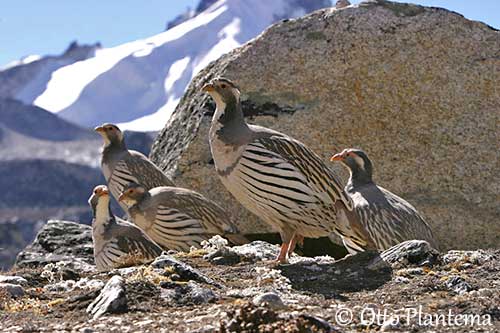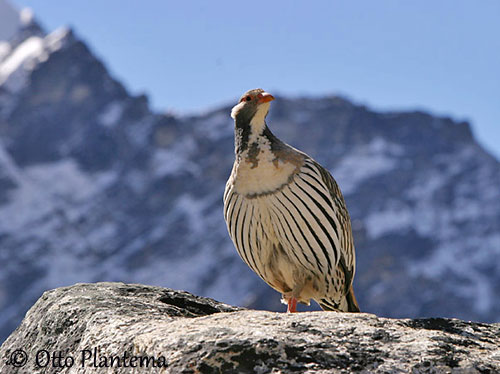
Fr: Tétraogalle du Tibet
All: Tibetkönigshuhn
Esp: Perdigallo Tibetano
Ital: Tetraogallo del Tibet
Nd: Tibetaans Berghoen
Sd: Tibetsnöhöna
Photographer:
Otto Plantema
Trips around the world
Text by Nicole Bouglouan
Sources:
HANDBOOK OF THE BIRDS OF THE WORLD Vol 2 by Josep del Hoyo-Andrew Elliot-Jordi Sargatal - Lynx Edicions - ISBN: 8487334156
L’ENCYCLOPEDIE MONDIALE DES OISEAUX - Dr Christopher M. Perrins - BORDAS - ISBN: 2040185607
Hennache, A. & Ottaviani, M. (2005). Monographie des faisans, volume 1. Edition W.P.A. France, Clères, France. ISBN: 2-9512467-1-4
Hennache, A. & Ottaviani, M. (2006). Monographie des faisans, volume 2. Edition W.P.A. France, Clères, France.ISBN: 2-9512467-2-2
Hennache, A. & Ottaviani, M. (2011). Cailles, Perdrix et Francolins de l'Ancien Monde, 400 pages. Editions W.P.A. France, Clères, France. ISBN 978-2-9512467-3-7
Les auteurs renoncent à leurs droits d'auteurs pour que la vente de cet ouvrage, publié par la World Pheasant Association, soit destinée à soutenir des projets de conservation.
BirdLife International (BirdLife International)
Wikipedia, the free encyclopaedia
Tibetan Snowcock
Tetraogallus tibetanus
Galliforme Order – Phasianidae Family
INTRODUCTION:
The Tibetan Snowcock of family Phasianidae is included in the subfamily « Perdicinae » with partridges and allies. Five species are found in this genus, all living in Eurasia.
According to the range and some morphological features, the Tibetan Snowcock could be the most primitive of the genus Tetraogallus. This species occurs at high elevation, up to 5800 metres during summer.
It has been described by John Gould in 1854.
DESCRIPTION OF THE BIRD:
Biometrics:
Length: 50-56 cm
Weight: M: 1500-1750 g – F: 1170-1600 g
The adult has heavily streaked plumage overall, with pale greyish-buff upperparts streaked dark grey, including the upperwing. Hindneck and mantle are greyish to pale buff and unstreaked. The short tail shows pale buffy-brown uppertail-coverts and black rectrices.
The underparts are white streaked black, more conspicuously streaked on body sides and flanks. Chin, throat and breast are white, with some irregular dark grey patches on upper breast and foreneck. We can see sometimes a narrow, pale grey breast band.

On the head, the forehead is whitish. Crown and nape are grey, like cheeks and neck sides. We can see a white patch on the ear-tufts. The eye is surrounded by red bare skin, extending slightly to the rear part of the eye.
The bill is reddish or horn-coloured according to the season. There is a small red wattle on both sides of upper mandible’s base in male. The eyes are dark brown. Legs and feet are reddish. The male shows a short spur on the rear of each leg.
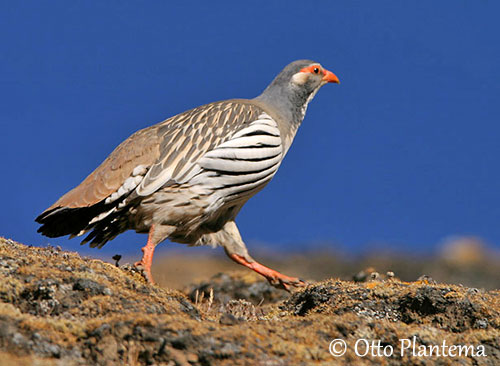
The female has similar plumage but she is duller and smaller. She lacks the spur. Head and neck patterns are less distinct than in male.
The juvenile resembles female but its upperparts show buffy shaft-streaks, and its underparts are usually unmarked.
The first year male has more conspicuous breast markings and pale whitish supercilium.
SUBSPECIES AND RANGE:
We can find four subspecies:
T.t. tibetanus (here described) is found in Pamirs and Tajikistan, SE to W Tibet and Ladakh.
T.t. przewalskii is found in NE India to WC China.
T.t. aquilonifer occurs in W Nepal E to Bhutan. This one is the darkest race.
T.t. henrici is found in E Tibet and to NW Sichuan.
These subspecies differ in head, nape and back colours.
HABITAT:
The Tibetan Snowcock frequents open slopes at high elevation, usually from 3700 metres up to permanent snow-line. In W Himalayas regions, this species can be found up to 5800 metres of elevation during summer, in grassy alpine pastures, stony areas and ridges with sparse grass, above the tree-line. During winter, they move to lower elevation, around 2450 metres.
When both T. tibetanus and T. himalayensis occur in the same areas, the Tibetan Snowcock is usually found at higher elevation.
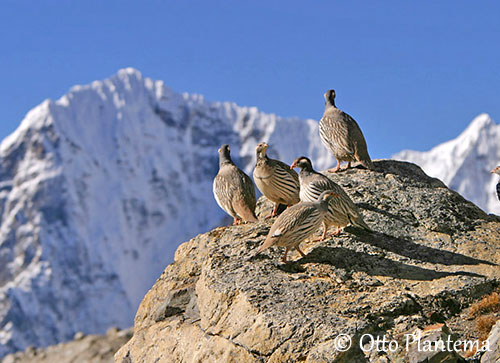
CALLS AND SONGS: SOUNDS BY XENO-CANTO
The Tibetan Snowcock gives far-carrying advertising calls, a series of several penetrating whistles.
We can also hear chuckling “chuck-aa-chuck-aa-chuck-chuck-chee-da-da-da”.
Several loud whistles are given when a group is flushed and takes-off.
As a gregarious but shy species, the Tibetan Snowcock has fairly large repertoire of sounds, used during social contacts and communication between group members.
BEHAVIOUR IN THE WILD:
The Tibetan Snowcock feeds mainly on plant matter such as roots, stems, leaves, seeds and berries. It forages on the ground among the sparse vegetation of the rocky slopes. It may walk over long distances, in order to find sufficient food sources.

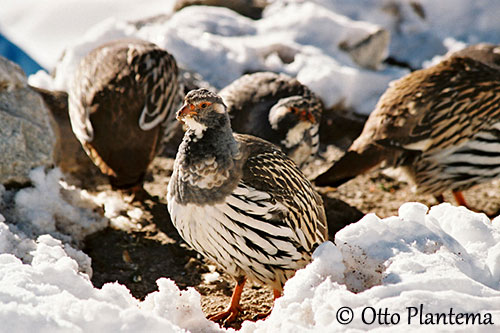
The cryptic grey and white plumage blends in the rocky and snowy landscapes in high mountains.
During the breeding season, males utter loud 5 notes whistles during the displays. They often call from rock, ridge or other high location, at dawn and dusk.
The courtship displays are poorly known, but we can suggest that several movements and postures are used to enhance the streaked plumage pattern, such as the typical frontal and lateral displays of Phasianidae. The male also fans its tail to show the contrast between the pale buff uppertail-coverts and the black rectrices.
In autumn and winter, the Tibetan Snowcock forms groups (coveys) of 15-20 birds. They perform altitudinal movements and reach lower elevation, moving down to 2500-4000 metres.
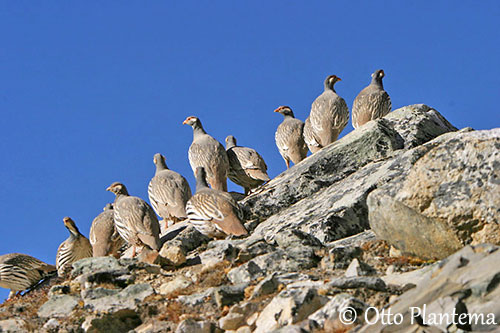
If disturbed, the Tibetan Snowcock reaches higher area or rocky ridge from which it can take-off to escape a danger. It is mainly terrestrial but it is able to fly very well once in the air. It glides long distances downhill on stiff wings while uttering whistling calls.
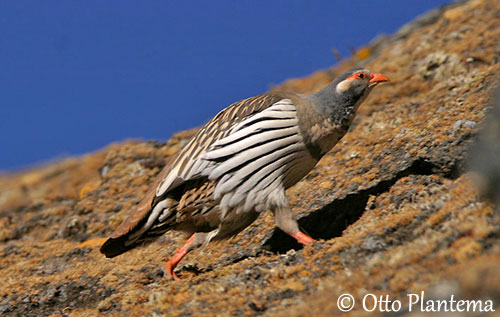
REPRODUCTION OF THIS SPECIES:
The breeding season occurs between late May and early July.
The Tibetan Snowcock nests on the ground. The nest is a shallow depression lined with some dead leaves and grasses. It is usually concealed under a bush or stones in rocky areas.
The Tibetan Snowcock is monogamous and both mates remain together during the breeding season.
The female lays 4-6 clay-coloured eggs with sparse darker spots. She incubates during 30 days while the male watches for predators and intruders around the nest-site. Both male and female rear the downy chicks. If threatened, they can perform distraction displays in order to move potential predators away from the nest.
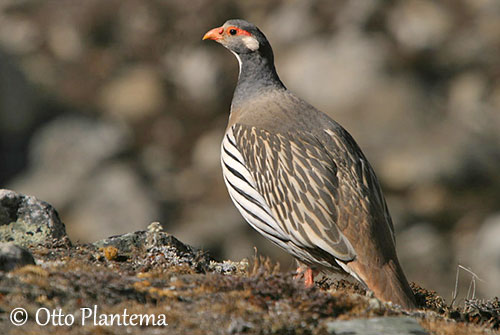
The chicks are precocial. Unlike most of other species, they are fed mainly on plant matter instead insects. The adults lead them to food sources where they can feed on their own. They are often brooded by adults during the first days.
The chicks are able to walk, run and jump by the third day, involving quickly flying abilities.
PROTECTION / THREATS / STATUS:
The Tibetan Snowcock has wide range where this species appears fairly common. Population size is very large and stable.
This species is not currently threatened, in spite of egg collection by local people, and increasing use of pesticides in high-elevation cultivated areas.
